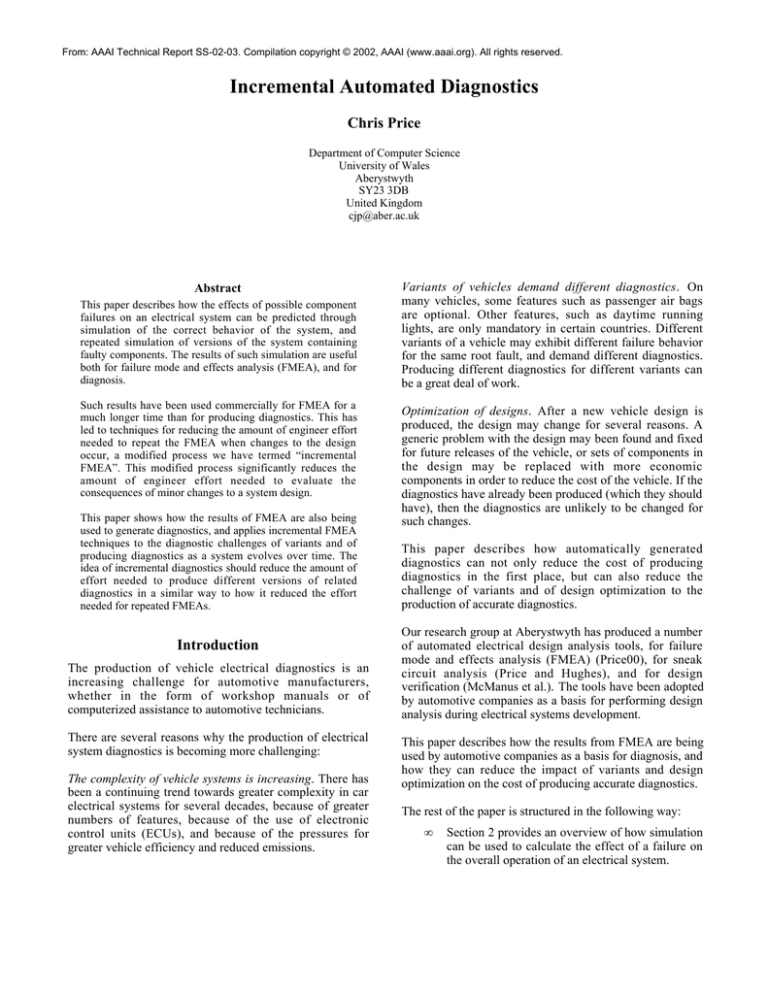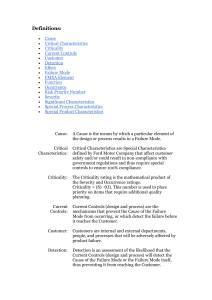
From: AAAI Technical Report SS-02-03. Compilation copyright © 2002, AAAI (www.aaai.org). All rights reserved.
Incremental Automated Diagnostics
Chris Price
Department of Computer Science
University of Wales
Aberystwyth
SY23 3DB
United Kingdom
cjp@aber.ac.uk
Abstract
This paper describes how the effects of possible component
failures on an electrical system can be predicted through
simulation of the correct behavior of the system, and
repeated simulation of versions of the system containing
faulty components. The results of such simulation are useful
both for failure mode and effects analysis (FMEA), and for
diagnosis.
Such results have been used commercially for FMEA for a
much longer time than for producing diagnostics. This has
led to techniques for reducing the amount of engineer effort
needed to repeat the FMEA when changes to the design
occur, a modified process we have termed “incremental
FMEA”. This modified process significantly reduces the
amount of engineer effort needed to evaluate the
consequences of minor changes to a system design.
This paper shows how the results of FMEA are also being
used to generate diagnostics, and applies incremental FMEA
techniques to the diagnostic challenges of variants and of
producing diagnostics as a system evolves over time. The
idea of incremental diagnostics should reduce the amount of
effort needed to produce different versions of related
diagnostics in a similar way to how it reduced the effort
needed for repeated FMEAs.
Introduction
The production of vehicle electrical diagnostics is an
increasing challenge for automotive manufacturers,
whether in the form of workshop manuals or of
computerized assistance to automotive technicians.
There are several reasons why the production of electrical
system diagnostics is becoming more challenging:
The complexity of vehicle systems is increasing. There has
been a continuing trend towards greater complexity in car
electrical systems for several decades, because of greater
numbers of features, because of the use of electronic
control units (ECUs), and because of the pressures for
greater vehicle efficiency and reduced emissions.
Variants of vehicles demand different diagnostics. On
many vehicles, some features such as passenger air bags
are optional. Other features, such as daytime running
lights, are only mandatory in certain countries. Different
variants of a vehicle may exhibit different failure behavior
for the same root fault, and demand different diagnostics.
Producing different diagnostics for different variants can
be a great deal of work.
Optimization of designs. After a new vehicle design is
produced, the design may change for several reasons. A
generic problem with the design may been found and fixed
for future releases of the vehicle, or sets of components in
the design may be replaced with more economic
components in order to reduce the cost of the vehicle. If the
diagnostics have already been produced (which they should
have), then the diagnostics are unlikely to be changed for
such changes.
This paper describes how automatically generated
diagnostics can not only reduce the cost of producing
diagnostics in the first place, but can also reduce the
challenge of variants and of design optimization to the
production of accurate diagnostics.
Our research group at Aberystwyth has produced a number
of automated electrical design analysis tools, for failure
mode and effects analysis (FMEA) (Price00), for sneak
circuit analysis (Price and Hughes), and for design
verification (McManus et al.). The tools have been adopted
by automotive companies as a basis for performing design
analysis during electrical systems development.
This paper describes how the results from FMEA are being
used by automotive companies as a basis for diagnosis, and
how they can reduce the impact of variants and design
optimization on the cost of producing accurate diagnostics.
The rest of the paper is structured in the following way:
•
Section 2 provides an overview of how simulation
can be used to calculate the effect of a failure on
the overall operation of an electrical system.
•
Section 3 explains how knowledge of the
relationship between a failure and its effect on the
overall system forms a basis for diagnosis.
•
Section 4 explores how FMEA generation can be
streamlined when identifying the effects of
incremental changes on the failure behavior of a
schematic.
•
Section 5 shows how the incremental FMEA
information can be used to produce diagnostics for
variants and to update diagnostics when a circuit
design has been optimized during production.
•
AutoSteve (Price00) uses simulation to generate a textual
report giving the effect of each possible component failure
on the behavior of the overall system. This is achieved by
performing a simulation of the correctly behaving system
under changing input conditions and abstracting the results
to the level of functions of the system. The result of the
simulation is a statechart of the possible behaviors of the
system. For the simple electrical example in figure 1, the
generated statechart would look like figure 2.
In order to explore failure behavior, the simulation is
repeated for versions of the system containing components
with faulty behavior. For a version of the circuit in figure 1
where wire W18 supplying the right fog lamp has failed,
the statechart is shown in figure 3.
Section 6 discusses some of the issues for
practical diagnostic systems raised by this work.
The effect of the failed component can be extracted by
comparing the two statecharts. So, for the example of wire
W18 failed open circuit, it can be seen that the only
difference is in the state on the far right. Instead of both fog
lamps being illuminated, only the left fog lamp is lit, so the
effect of the failure is that the Right fog lamp does not
illuminate when both the switches are closed.
Automated Analysis of Failure Effects
Failure mode and effects analysis (FMEA) is a design
discipline where every possible failure on a design is
considered, and the effects of the failure on the operation
of the overall system are calculated, in order to identify
severe, frequently occurring failures, and eradicate them
from the design if possible.
Ground
W1
Fog
Lamp
Switch
W3
W9
W2
Main
Lamp
Switch
W4
Battery
W10
5A
+12V
S1
W7
+
W12
W11
W5
ECU
Relay 1
W6
Main headlights
W19
W8
S2
W17
W14
S3
W23
W16
Relay 2
W20
W13
W15
Ground
W24 S4
W21
W27
Right
W26
Left
W18
W25
Left
W22
S5
Right
Fog lights
Figure 1: Main beam and fog lamp example circuit
S6
Main beam switch closed
Foglamp switch open
Close main headlamp switch
Close foglamp switch
Main lamps on
Fog lamps off
Main beam switch open
Foglamp switch open
Main lamps off
Fog lamps off
Open main
beam switch
Open fog
lamp switch
Open fog
lamp switch
Open main
beam switch
Main beam switch closed
Foglamp switch closed
Main lamps on
Fog lamps on
Main beam switch open
Foglamp switch closed
Close foglamp switch
Main lamps off
Fog lamps off
Close main headlamp switch
Figure 2: Statechart for good system behavior
Main beam switch closed
Foglamp switch open
Close main headlamp switch
Close foglamp switch
Main lamps on
Fog lamps off
Main beam switch open
Foglamp switch open
Main lamps off
Fog lamps off
Open main
beam switch
Open fog
lamp switch
Open fog
lamp switch
Open main
beam switch
Main beam switch closed
Foglamp switch closed
Main lamps on
Left fog lamp on
Main beam switch open
Foglamp switch closed
Close foglamp switch
Main lamps off
Fog lamps off
Close main headlamp switch
Figure 3: Statechart for system behavior with wire W18 failed open circuit
The simulator normally used in AutoSteve is a qualitative
simulator (Snooke); it does not need exact resistor values,
but is able to produce results using resistor values of zero,
load and infinity. This is appropriate for design analysis,
because it means that useful results can be produced as
early as possible in the product lifecycle. However, more
accurate results can be produced by the time that the
engineers are ready to produce diagnostics, and so
AutoSteve can also work using the commercially available
SABER simulator. This produces numerical results, and
abstracts them to the same functional level reports as are
produced from the qualitative simulator.
Part of the process of performing FMEA is for the engineer
to consider the effects of each failure, and see whether any
changes to the design are needed to mitigate the effects of
the failure. This means that each link between component
failure and system failure effect has been considered and
validated by a design engineer. This is reassuring when
considering the use of such information in diagnosis.
•
Automatically generate the text and diagrams for
the manuals from the FMEA and the schematic.
•
Arrange in suitable order for the manual.
•
Add any additional failures that are not electrical.
Use of FMEA results for diagnosis
For FMEA, analysis begins with each potential failure on
each component, and generates the possible effects of the
failure. Many different failures may have the exact same
effect. For example, failure of wire W22 or of the right fog
lamp itself would have the same effect as the failure of
wire W18 shown in figure 3. The important end result of
FMEA is a table of failure/effect pairs for every possible
potential component failure. This is a simplification, as
each pair will also have associated information that could
be of interest for diagnosis, such as the likelihood of
occurrence of the component failure, but the most
important information is the failure/effect pair.
For diagnosis, the effects or symptoms are the starting
point. Typically, the driver of a vehicle will detect a
problem - a lamp fails to illuminate, or the engine is slow
to respond to the throttle - and they will want to know what
component failure caused the observed behavior in order to
repair the system. The contents of the table of failure/effect
pairs can be rearranged to produce a list of all component
failures that could cause each specific effect. This is
discussed in more detail in (Price and Taylor).
More recently, we have been working with an automotive
manufacturer to explore the use of AutoSteve FMEA
results for the production of both workshop manuals and
computer-based service bay diagnostics. The workshop
manuals deal with the electrical systems that are not
electronically monitored from an electronic control unit
(ECU), and start from driver-level symptoms.
We have studied typical diagnostic trees within the
manuals. They guide the technician to runs of wires that
might be responsible for a specific failure. The FMEA
results can be rearranged to produce results equivalent to
those produced by engineers. The results from the FMEA
also cover more obscure combinations of symptoms that
are ignored when the lists are generated by hand. Because
the symptoms are generated from an electrical FMEA,
some failures are not included, because they cannot be
simulated. For example, in a radio system, failure of the
radio to work because the aerial is no longer connected
would not be covered.
The result of this work is a process for producing
diagnostic manuals from FMEA results as follows:
•
Obtain the on-line schematic for the system from
design staff.
•
Run the automated FMEA software on the
schematic (all component models for doing so will
have been produced during design).
Where electrical systems are monitored by an ECU, online
fault detection software will detect most problems, and
generate a diagnostic trouble code (DTC) indicating the
symptom. DTCs give a more exact indication of likely
problems, and when the service bay technician connects
the car to a diagnostic computer, software guides the
technician in pinpointing the problem. The software directs
the technician in the order in which tests should be carried
out, taking into account such factors as likelihood of a
specific failure and the cost of performing a particular test.
Automating the production of software for pinpointing the
failure causing a DTC is more difficult than automating
diagnostic manuals, but is worth doing because producing
the software by hand is so much work. The process for
achieving this is:
•
Obtain the on-line schematic for the system from
design staff.
•
Add descriptions of functions corresponding to
each relevant DTC (the original functions
monitored corresponded to the user-level
symptoms, not the symptoms that the DTCs
detect).
•
Run the automated FMEA software on the
schematic (all component models for doing so will
have been produced during design), generating the
set of failures that could cause each DTC to fire.
For each DTC:
o Automatically order the possible failures
by their likelihood.
o Allow the user to change the order. This
cannot be done automatically as there is
no information about cost of tests.
•
Generate the code for the diagnostic system from
the ordered set of failures that could cause each
DTC to fire.
The processes outlined above significantly reduce the
amount of time needed to produce diagnostics. As the
FMEA system works efficiently for multiple failures (Price
and Taylor), it can also produce diagnostics that cover
multiple failure cases.
However, there is a good amount of work to be done in
order to diagnose variants of systems, and to reflect
changes to the design of a system over its lifetime. The
next two sections describe how the FMEA software deals
efficiently with incremental changes to a design, and how
that strategy can be extended to provide an efficient answer
to the problem of variants and changing designs.
Incremental FMEA
In (Price96), we describe how the consistent nature of the
FMEA produced by AutoSteve makes it possible to
produce incremental FMEA results showing the difference
that has been made to a design by a set of design changes.
The first time an FMEA is run on a system, it might take an
engineer a day or so to absorb all of the implications of the
FMEA report generated by AutoSteve (as opposed to a
month or two to generate such results by hand for a
complex system). When a change is made to the system,
perhaps as a result of a problem being identified by the
FMEA report, then the FMEA can be re-run, and
automatically compared row by row with the previous set
of results.
The results of comparing the FMEAs fall into four
categories:
1. The results are the same for the same component failure
in each case. This covers the majority of cases, and can be
ignored as the engineer has already considered this.
2. The results no longer exist, because the component has
now been deleted. This is also of no interest.
3. The results differ because the failure effect when this
component fails has changed. This category is important,
as some of the worst problems in vehicles are introduced
by late changes to the vehicle, and items in this category
should be studied carefully.
4. The results are new, because the failed component did
not exist in the previous version of the schematic. This
category also has to be studied, because failures in this
category have not yet been checked out by an engineer.
Only categories 3 and 4 are presented to the engineer as the
results of an incremental FMEA. In (Price96), two versions
of the schematic in figure 1 are given as an example, the
first with a single fuse as shown in figure 1, and a second
where each set of lamps is fused separately from the ECU.
In the latter case, complete loss of lighting is avoided when
one of the wires to the lamps shorts to battery. Only a small
number of changes between the two designs are shown to
the engineer as a result of repeating the FMEA, making
incremental FMEA a sustainable and efficient practice.
Automated Incremental Generation of
Diagnostics
A good amount of the work of producing diagnostic
systems is achieved by the automated generation of
potential failures causing each possible symptom. The
remaining work is in suitably arranging the candidates for
presentation in a manual or for service bay testing, and in
adding any potential failures that cannot be modeled
electrically.
Repetition of this work can be minimized by the use of
software tools that record all operations performed on the
output of the automated FMEA. The candidate failures for
each symptom (driver-level symptom or DTC, depending
on what kind of diagnostic system is being constructed) are
presented to the diagnostic system building engineer
(DSBE) by the software, and the DSBE can change the
order in which the failures are investigated, and can add
extra failures. All reorderings and additions are logged by
the software.
Where a variant is drawn as an addition to a basic
schematic or a change is made to a design, then
incremental FMEA can be used to produce the differences
in causes for possible symptoms. The information about
the way in which the previous version of the diagnostic
system was ordered can be used to produce the basis of the
diagnostic system for the new version (reordering tests and
adding non-electrical failures), and the differences from the
previous version can then be added interactively by the
DSBE.
This would significantly reduce the amount of effort
needed to change the diagnostic system as the design
changed or as variants of the design were produced.
Related Issues
Better on-line assistance
While this paper has discussed the production of workshop
manuals, these are now seldom produced in paper format
for use by professional mechanics - although there is still a
market for paper-based manuals for the amateur enthusiast.
For the professional, it is much more common for such
information to be delivered via computer.
The kind of technology discussed in this paper brings us
close to the workshop manual being automatically
generated "on the fly". The engineer would enter the
vehicle identification number (VIN) of the vehicle. The
VIN would be used to access a database containing the
variants used in building the vehicle, and the correct
diagnostic system for the problem could be constructed as
described earlier. More ambitiously, it would be possible to
take into account any modifications made during afterservice if they were properly recorded in a database. Such
tracking of a changing design might be too much effort to
expect for a car, but would be much more appropriate for a
plane with a 30 year lifespan and several refits during its
lifetime.
Another advantage of such technology is that it is based on
simulation. It would be possible to provide engineers with
interactive versions of the schematic, where they can
choose symptoms, be shown all possible faults that could
cause the symptoms, select a fault, and see the detailed
effects of that fault in simulation.
Wider application of these techniques
Our own work in using model-based simulation to produce
diagnostics has, for the most part, been limited to electrical
systems, but there has been a good deal of work in other
domains, for example (Sachenbacher and Struss) in
hydraulic systems, and (Cascio et al.) in a variety of
automotive domains. These efforts are not as commercially
advanced as work in the electrical domain, but as the
efficiency of modeling in these other domains improves,
one would expect similar benefits to those being
experienced in the electrical domain.
Conclusions
Electrical systems have proved to be a successful domain
for the application of model-based reasoning. They are
simple to model, but complex enough that it can be
difficult to understand the consequences of component
failures. The commercial advantages of such technology
for design analysis are clear.
The use of design analysis results (specifically, the results
from FMEA) for the production of diagnostics has a
number of significant advantages:
•
The diagnostics are based on information provided
by design engineers, and the effects of component
failures will have been validated by design
engineers. This provides a much closer link
between design and diagnosis than is often the
case in large corporations.
•
Much of the effort of producing the diagnostics is
automated. Generation of a fault population and
much of the work of ordering the population can
is done by software.
•
Incremental FMEA techniques help produce
different versions of diagnostics. Techniques for
dealing with design changes efficiently can be
applied to the production of diagnostics and
greatly reduce the effort of producing diagnostics
for different variants, and correct diagnostics as
systems evolve through different versions.
Acknowledgements
Some of the work described in this paper was supported by
the UK Foresight Vehicle program under EPSRC grant
GR/N06052, and done in collaboration with FirstEarth
Limited.
References
Cascio, F; Console, L et al. 1999. Generating on-board
diagnostics of dynamic automotive systems based on
qualitative models, in Proceedings of the 13th International
workshop on Qualitative Reasoning, pp265-283, Loch
Awe, Scotland.
McManus, A.G.; Price, C. J. ; Snooke, N.; and Joseph, R.
1999. Design Verification of Automotive Electrical
Circuits, in Proceedings 13th International Workshop on
Qualitative Reasoning, QR'99, Loch Awe.
Price, C. J. 1996. Effortless Incremental FMEA, in
Proceedings of Annual Reliability and Maintainability
Symposium, pp43-47, Las Vegas, Nevada.
Price, C. J. 2000. AutoSteve: Automated Electrical Design
Analysis, in Proceedings ECAI-2000, pp721-725, Berlin,
August 2000.
Price, C. J. and Hughes, N. 2002. Effective Automated
Sneak Circuit Analysis, in Proceedings Annual Reliability
and Maintainability Symposium, Seattle, January 2002.
Forthcoming.
Price, C. J. and Taylor, N. S. 1997. Multiple Fault
Diagnosis Using FMEA, in Proceedings AAAI97/IAAI97
Conference, pp 1052-1057, Providence, Rhode Island.
Sachenbacher, M. and Struss, P. 1997. Fault isolation in the
hydraulic circuit of an ABS: a real-world reference
problem for diagnosis, Working notes of the 8th
International Workshop on the Principles of Diagnosis,
(DX-97), pp113-119, Mont-St-Michel, France.
Snooke, N. 1999. Simulating Electrical Devices with
Complex Behavior. AI Communications 12 (1,2), p45-59.








